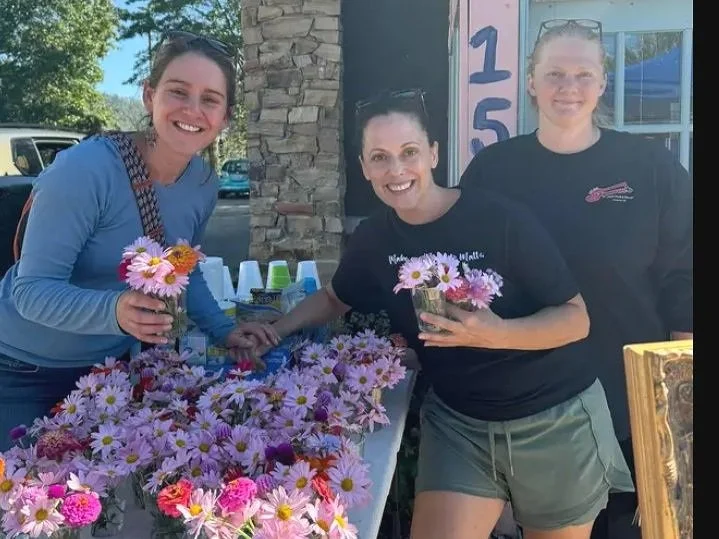A Lesson in Love from the Flowers of Hurricane Helene
February 10, 2025
Garden flowers on their way to local relief hubs in East Asheville, NC following the destruction of Hurricane Helene
The morning after Hurricane Helene demolished Asheville, North Carolina our cove was bizarrely still. Yet this sense of calm was just ignorance of what had occurred and the utterly blessed fortune of our home’s location on the “right” side of the mountain. Of course, the night before had some adventures. We set alarms every three hours to pump water out of the flooding basement until 5:00 am when we lost power and our electric pump system turned into bucket brigades lit by headlamps while we stood in six inches of water. With no power, no cell service, and honestly no clue of the immense destruction that had torn through our WNC community, my family was left with the immediate present moment and state of our close surroundings. Miraculously, no huge trees had fallen near our home. While there were many trees to be cleared in the coming days to open up our only access out of the cove, we were unbelievably lucky. I climbed the hill up to my beloved garden to greet the flowers, a treasured morning ritual that called me even under such intense circumstances.
The zinnias and cosmos of early fall were still holding on with tinges of late blight and a few more tired blossoms each day. I savor every moment with these flowers until they succumb to the first freeze, and I methodically prune them to enjoy each gift until that moment. That morning after the storm my leggy cosmos and zinnias were on their sides, yielding to the winds that brought down hundred-year-old oaks. I slowly visited plant by plant, propping them back up, digging their roots back into the earth, and speaking of their strength with the hope that I might squeeze out a few more weeks of their companionship. Our days following this strange and quiet morning became blurs of chaotic missions for supplies, chainsawing trees to clear roads, and attempts to find a wifi signal to find out any information about the situation or contact loved ones. The more we came to understand, the more our minds could not comprehend. Chinook helicopters, chainsaws, and sirens became the soundtrack to our lives for the next few weeks.
As we started making connections in our community, learning of locations for food, supplies, hubs for community and connection, we simultaneously experienced more love and more pain. Unexpected routes to avoid closed roads revealed damage and destruction beyond belief. Someone accurately summed this up as a mind-bending experience. As I attempted to take in this incomprehensible situation and stay hopeful, my visual field was soaking in the dark, the mud, debris, trash, and pain. It became unbearably hard for us sensitive beings.
Thai-inspired flower garland offering, strung a few days after the storm
I remember one afternoon several days after the storm I knew I needed help. I sat on the ground in my garden for hours, methodically picking and stringing marigolds and gomphrena on long needles into garlands, a Thai-inspired skill I had recently begun exploring a few days before the storm. I remember both loving this moment and cursing myself for doing something as frivolous as making flower offerings when there was so much suffering and so much work to be done. There were people out there throwing themselves into incredible humanitarian efforts. Although my husband and I offered our support at various supply hubs and other needs in our cove, I had thrown my back out after the first few days of moving huge branches and logs from fallen trees and bucketing water from our flooded basement. My capacity for actually “making a difference” seemed limited. The physical and emotional chaos of the entire situation had become so intense, yet in that quiet moment in the garden my heart felt softened and my mind soothed. Remember, the flowers are also healers. Messages from the plants don’t come to me in words but more like knowings, and this message created inspiration and a small, yet beautiful opportunity. Two weeks after the storm the soaked earth received days and days of glorious sunshine and mild temperatures, which was a small gift to all of us, including the plants that survived. My flower beds were producing hundreds of pink chrysanthemums and begged to be shared. I began filling boxes that had arrived in Asheville from around the country with disaster relief food and items with flowers, dozens and dozens of colorful, vibrant bouquets. I connected with friends who were organizing supply hubs and delivered the flowers with hopes that folks would understand that even when everything feels confusing and dark, the earth will hold our pain, and transform our grief. The beauty of nature is here for all of us. I do see the irony in this - after we had just endured a catastrophic hellscape from nature’s power. And during this time many of us learned to hold two seemingly contrasting truths in our hands and hearts.
Delivering flower bouquets at a hub in Cane Creek, NC to the site coordinators.
One morning I pulled into a hub in Cane Creek, one of the more hard-hit areas of Asheville, and saw a woman sitting in her car that was packed full of clothing and boxes. Her window was down and I noticed several empty drink bottles scattered on the floorboard, and she was talking frenetically on her phone. I took a bouquet and passed it through the open window to her and offered a smile. She first looked at me with confused and harsh eyes, and then I watched her face soften as she received the flowers. She completed her call and looked at me with tears in her eyes. “You have no idea how much I needed this,” she said to me. We spent the next hour chatting. I learned that she was making a huge life transition when the storm hit and was desperately trying to find a way to catch a flight out to Spain. We discovered many shared connections to places and experiences throughout our lives. As I said goodbye she opened up the back of her car and showed me a box of supplies she had picked up and said, “Do you need anything?” I thanked her and took a few packages of ready-to-eat lentils, not because I really needed them, but because I had become quite fond of this energetic exchange of material and care that our community developed after the storm.
The flowers found their way to a small community in Swannanoa where entire neighborhoods had been washed away, flooded, all the memories erased in one terrible storm. The homes I visited were high on a hill, safe from the floodwaters, yet the people who lived there were experiencing the extreme fatigue and survivor guilt that many of us came to understand. They had been working tirelessly to help family and friends who had lost everything. The flowers found their way to a church parking lot where a huge, burly man with a long beard and sleeveless t-shirt had come from Missouri with his truck and trailer hauling a BBQ pit and set up shop for weeks offering hot meals and debating with the group across the lot from Virginia about who has the best BBQ? My husband and I were particularly tired that day as the charm of outdoor cooking and survival-skill flexing had lost its appeal about eight days in. We graciously received a couple of styrofoam containers filled with food and I hopped out of my car and handed him a box of flowers. “Will you please pass these out to folks when they come by for a meal?” I asked. He said of course and let me grab a quick photo to document the awesome juxtaposition of his oeuvre with the box of dainty blossoms. If anyone has endured a natural disaster or a particularly dark time in their life, I imagine they have also come to learn how love comes in so many forms and how there is so much good out there in humanity. I am quite certain that the man at the church and I have opposite political perspectives, likely different beliefs about self-expression and God, yet that moment was just a clear exchange of beauty and kindness. As I drove away I envisioned folks sitting down that evening with their meals cooked by kind souls and flowers blessing their tables.
About four weeks after the storm my husband and I were driving along a highway and passed a strip of land where hundreds of sunflowers once stood, (a lovely experience you see when driving the highways of North Carolina thanks to a vision Dotti Martin initiated about forty years ago.) I had become so accustomed to looking beyond the destruction to avoid fully taking in all the intensity, but that day, something caught my eye. I turned my head to see that the ends of the flower stalks had bent up to the sky. While mud-covered, they were standing about eight inches off the ground with a handful of new blossoms. I burst into tears in that moment when nature so wonderfully reminded me, once again, of the enduring strength and possibility when we decide to turn toward the light.





